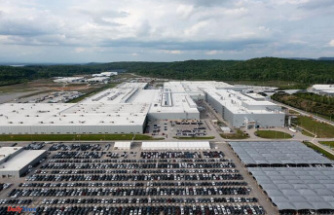Global warming, ocean pollution and overfishing are taking their toll on corals. One solution could be super corals, which are better able to cope with environmental pollution. The first steps towards breeding them are already being taken.
When most people think of coral, they think of the Great Barrier Reef. It consists of over 3000 individual reef systems and coral bays, which in turn are home to countless sea creatures. And yet this is only a tiny part of the seas that corals have colonized.
The strange organisms had puzzled researchers for several centuries. It is now clear that corals are assigned to the class of anthozoans in the animal phylum Cnidaria, which also includes sea anemones and jellyfish. They are small animals called polyps that can form colonies. These polyps form a common skeleton, which in some species forms the foundation of a coral reef. Corals form hard carbonate exoskeletons that support and protect the coral.
"Stony corals that build the reefs have existed for 250 million years with an almost unchanged construction plan and have been exposed to more extreme environmental conditions in the history of the earth than they are now," says Christian Wild from the University of Bremen, which is organizing the 15th International Coral Reef Symposium ICRS this week . 1,100 researchers from more than 80 countries are expected to be there, and around 500 experts want to join in virtually.
The main topic of the conference is the protection of these sensitive ecosystems. Because the long history of corals does not mean that they simply put up with the massive changes caused by the climate crisis. Every year, large coral bleaching events kill reefs that have grown for decades.
Coral bleaching is a phenomenon that occurs when corals are stressed and then shed the colorful algae that live within them. The trigger for this is the constantly rising water temperatures. If these are too high for several days, the relationship between the coral animal and its microscopic symbiotic algae is disrupted. If this condition does not improve, the corals die within a few months. As a result of back-to-back heat waves in 2016 and 2017, this is believed to have affected 50 percent of the coral on the Great Barrier Reef.
Scientists fear that coral reefs could be one of the first ecosystems to be irreparably altered unless the world's carbon emissions are significantly reduced quickly. Encroachments on coastlines, increasing pollution and overfishing are additional damaging factors. According to Wild, measures such as the development of sustainable fishing quotas against overfishing and the construction of sewage treatment plants to combat over-fertilization are high on the agenda, but a lot can also be achieved with the active restoration of reefs using particularly heat-resistant so-called super corals.
The coral reefs of Palau, an island nation in the Pacific Ocean, proved to be relatively resilient. The Coralassist project, funded by the European Research Council Horizon 2020, is now specifically looking for more heat-tolerant corals there. The goal is to breed them. In this way, the international team, led by researchers from the University of Newcastle, wants to buy time for some valuable reefs in order to combat the causes of their death.
Reefs are inherently resilient and can regenerate after a major bleaching. But they need time for that. Normally, damaged reefs take between five and ten years to return to anything close to their original condition. If the intervals between bleaching events become too short, for example as little as a year or two, vital recovery processes may fail.
The researchers are therefore looking for solutions. In order to get more robust corals, small pieces of coral, so-called "nubbins", were first subjected to heat stress tests. The temperature in seawater tanks was slowly increased to simulate coral bleaching. Even within a single population, there was no uniform response. The hardiest corals were then taken to the lab to spawn just before spawning season. In a special issue of the magazine "Environment, coastal and offshore" on the occasion of the coral conference, the scientists describe the enormous challenges. 'This is by no means an easy task, as corals only spawn on certain nights once a year. If this event is missed, we will have to wait a full year to get another chance,' they write.
The offspring corals from the laboratory are then grown partly in aquariums and partly in nurseries near the reef. If they are big enough, the baby corals can be transplanted directly into the reef. Whether the offspring turn out to be just as tough as their parents is then checked in further heat stress tests at different life stages. The goal is to seed more of the more resilient corals into the reefs to test whether this increases the population's average heat tolerance. If successful, it is expected that a higher proportion of the corals raised will survive the next bleaching event in the sea.
So far, the researchers have succeeded in identifying 14 potential parent animals for breeding from the two species Acropora digitifera and Goniastrea retiformis and in developing crosses from them. More than 600 juvenile corals were transplanted into a reef. It turned out that the survival rate of corals with a diameter of less than one centimeter was particularly low because fish grazed on them. In the meantime, the researchers have switched to longer rearing, which means more work and higher costs.
The scientists underline the need to develop innovative methods to avoid early mortality, shorten rearing times and increase survival rates. Among other things, they bring up the development of special substrates for baby corals that offer protection against fish damage and constructions that can be quickly and easily attached to the reef.
It is still too early to make a final assessment of the results, but the tests on offspring show encouraging signs that heat tolerance has a strong heritable component, according to the researchers. It is now necessary to find out whether the increased tolerance lasts for the coral's lifetime and whether there are interactions between heat tolerance and coral growth, fertility or the reproductive performance of the animals. For this, the marked coral colonies must be monitored regularly. There are also plans to genetically sequence the corals and their microbial symbionts. The aim is to identify proteins that play a role in protecting corals from heat stress.
The research group says it is encouraging to see how far the project has come so far. "But there is still a long way to go before the work we are doing will have a real impact on conservation," the Coralassist team points out. Coral reef time is running out and it is not yet clear if these innovations can be translated into solutions.












